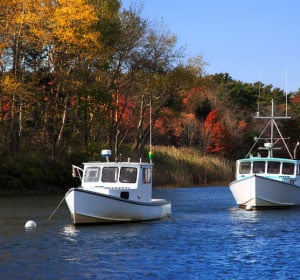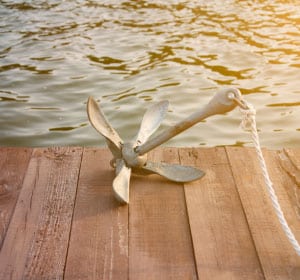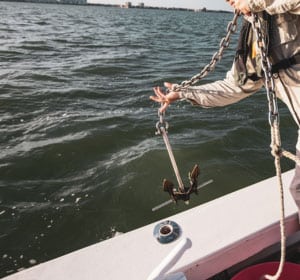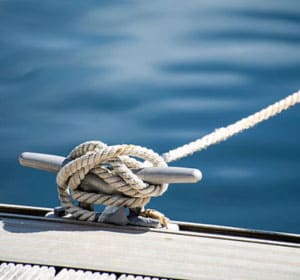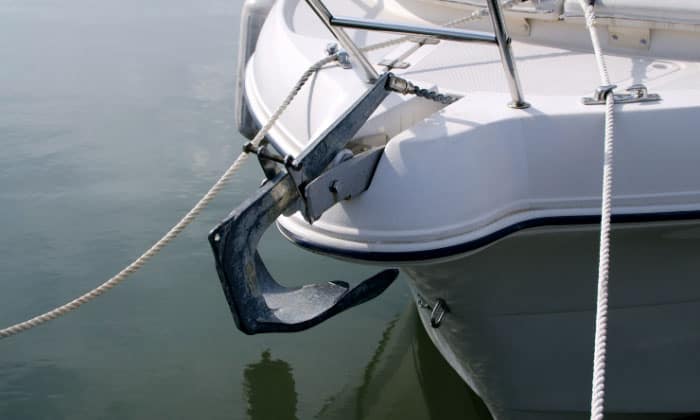How to anchor a boat in a lake? Even professionals find anchoring hard sometimes, let alone newbies. Not knowing how to anchor properly can be bothersome as you may damage other vessels and your own. Anchoring situations also vary depending on where you anchor the boat, in this context, at a lake.
In today’s article, we’re going to show you a guide on how to properly anchor your boat in a lake as well as anchoring mistakes to avoid. Stay tuned!
Table of Contents
Step-by-step To Anchor A Boat In A Lake
What to Prepare
Before we get to the anchoring steps, there is preparation to be made. You’ll need:
- Anchor
- Rode
- Cleats
Step 1: Choose A Spot
Eye on a good location to anchor your vessel using nautical charts; they usually have numbers to indicate water depths, which are either measured in feet or fathoms.
You’d want to anchor in shallow water with a good holding bottom (preferably sandy or muddy), or else the anchorage may drag or reset.
If you don’t have a nautical with you, make use of electronics to measure the depths to estimate how much rode you’re going to use.
There should also be sufficient room in case the boat drifts and damages other boats. It takes experience to figure out how much space is needed, but you’ll get there.
Before anchoring, make sure you have a grasp of the local boating regulations and anchor lake available to avoid paying unnecessary fines.
Step 2: Prepare For Anchoring
Once you have settled with a location, slowly idle upwind to the confirmed spot. As you stop the boat completely, the wind and current will eventually push the boat away from where you want to end up, so try not to take too much time dropping the anchor.
You ought to assess the sufficient amount of rode before dropping your anchor.
In terms of anchoring, there is a term called ‘scope,’ which refers to the ratio between the rode length used and the distance from the bow to the bottom. Ideally, 7:1 is the desired scope for normal weather conditions, but 5:1 also works.
Let’s say your bow is 4 feet above the water surface, and the water depth is 20 feet. Following the 7:1 scope, you’d need 168 feet of rode. By now, you should know the bow height of your vessel from the water. It usually ranges from 4 feet to 6 feet, depending on your boat size.
In stormy weather, increase the scope to 10:1.
Step 3: Set The Anchor
Time to deploy the anchor.
Preferably, you’d want to go for a controlled drop with a windlass. If you’re anchoring manually, do not throw the anchor in the water at one go; that way, you won’t have much control over the amount of rode spent, resulting in an inattentive anchorage.
Before anchoring, it is recommended that you lay the rode out to avoid snarls and tangles. You should also wear protective gloves during the process so you don’t get rope burns.
The best way to moor a boat in a lake is to slowly lower the anchor to the water over the bow.
Do not start from the stern; this may cause the boat to swamp, if not capsize. The only time you drop the anchor from the stern is when you want to perform double anchoring for fishing, which is to anchor a boat front and back.
The trick to a successful anchorage is to grab the rode tightly at first to control how much rode you want to let out, then gradually loosen it as the anchor hits the bottom.
Once ⅓ of the rode is let out, slightly pull it back to allow the boat to straighten. If your boat won’t sort out, chances are you had a failed anchorage; redo the steps until your vessel succeeds to straighten, then two more times when ⅔ of the rode is let out, and when it’s entirely reached the bottom.
As the anchor is setting, allow the boat to run backward at a low output to aid in the anchorage, but make sure not to drift back too far away from your initial spot.
Step 4: Tie Off The Anchor
If you’re new to anchoring a pontoon boat, it’s okay to fail your first attempts. Pull the anchor back up from the water, and redo all the steps until the rode is extended and tightened. Then, it’s time for you to tie the anchor off.
Secure the bitter end of the rope/chain around your bow cleat using a cleat hitch, then pull on the rode to ensure the anchor is not dragging.
Should you plan to stay overnight, we recommend you add a chain that measures ½ of the boat’s length for better stability.
Voilà, those are the anchoring techniques required to properly anchor a pontoon boat or any other vessel of the same size.
Other Anchoring/Retrieving Tips
Find below some retrieving tips as well as the mistakes to avoid when anchoring your boat in a lake.
Retrieving Tips
- Pull the rode with the help of a person controlling the helm so that your vessel is in a vertical direction with the anchor.
- As the anchor is pulled up, avoid dragging it along the bottom as much as possible so mud and debris are reduced to the minimum.
- If the anchor gets stuck, maneuver the vessel to go in a large circle whilst still pulling the anchor line tightly. That way, you’ll get the anchor to break loose easier.
Mistakes to Avoid
- Not using a big enough anchor – If you’re wondering why your anchor keeps dragging, this is probably the reason. Look for an anchor associated with the size of your boat for better anchorage.
- Using the wrong type of anchor – General purpose fluke anchors are quite popular on the market as they offer more staying capability than regular ones.
If you plan to anchor in areas of high current, opt for plow anchors. On the other hand, mushroom anchors come in handy for short-stop anchoring; they’re also preferred for small boats.
All in all, do some research on the suitable type of anchor for your needs.
- Not having sufficient scope – As mentioned, knowing the sufficient scope is one important factor contributing to great anchoring.
Besides preparing enough rodes, you should also check the current, the wind as well as the highest and lowest points of the tides in the area you’ll be anchoring in.
Usually, you rarely get depth changes or tide variations when you anchor a boat in wind at a lake. Thus, you can skip the tide swing estimation.
- Not laying out the rode – Laying out the rode will not only prevent it from twisting and tangling but also ensure the rode won’t pile up on top of the anchor.
Conclusion
How to anchor a boat in a lake? By now, you should know the boat anchoring rules as well as how to tie anchor on pontoon boat at a lake!
Don’t frown if you don’t know how to properly anchor your boat at a lake yet; you’ll get there. Practice makes perfect. Even though anchoring a boat isn’t always the same each time, at least you’re familiar with the basis after today’s article.
And don’t forget, investing in the right anchor goes a long way in the future. Stay safe and have fun on the water!

Ten years of enjoying countless trips on boats never made me love them any less! So I am here to put all those experiences into good use for other boaters who want to have a safe and fun trip with their friends and families.


